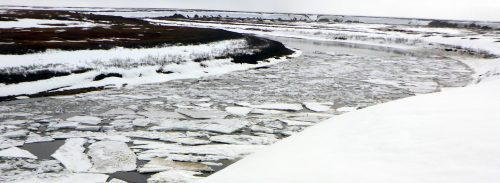Scientists, forecasters ask Alaskans for river breakup information
April 23, 2020
Heather Rebekah McFarland
907-474-6286
Alaskans can help the National Weather Service monitor rivers during a potentially dangerous breakup this year through a University of Alaska Fairbanks citizen science project.

Deep snow and thick ice across much of Alaska have heightened river flooding risks this spring. At the same time, the coronavirus pandemic has limited the National Weather Service's ability to monitor conditions.
UAF’s citizen science project, Fresh Eyes on Ice, is recruiting community members to fill data gaps about spring river ice conditions
in Alaska.
Thanks to the Anchorage-based company, Axiom Data Science, the project already has
a web portal and mapping software where anyone can submit river or lake ice observations and photos.
“The best way for people to contribute right now is taking a photo and a little report,”
said Karen Endres, a NWS hydrologist. She emphasized that providing regular reports,
even when there is not currently any change, helps NWS predict how and when river
breakup may progress.
Fresh Eyes on Ice is an observing network, with a focus on community-youth partnerships,
that monitors frozen rivers and lakes and their role in the environment and Alaskans’
lives.
“In our first year, we’re working with six different communities around the state," said project leader Chris Arp, a hydrologist at UAFs Water and Environmental Research Center. "Each has real time ice monitoring buoys along with river cameras, and youth groups who make field measurements. Our plan is to recruit six more communities to expand this program for next winter.”
In normal years, the NWS Alaska-Pacific River Forecast Center monitors river ice conditions that feed sophisticated river break-up forecasts. Alaskans across the state rely on these forecasts for updates on river break-up timing and conditions.
This year is anything but normal. Thick ice covers Alaska rivers, and a deep snowpack lies in the surrounding mountains. All that ice and snow is expected to melt rapidly, increasing the risk of dangerous ice jam flooding.
In addition, the coronavirus pandemic has limited travel and the amount of river data that NWS can collect.

“UAF can fill gaps. We already have these tools built in. We can make a real difference here,” said Katie Spellman, Fresh Eyes on Ice project co-leader, ecologist and science educator at UAF’s International Arctic Research Center.
According to Spellman, stepping in to help fill gaps is not only the right thing to do but also a project goal. Fresh Eyes on Ice aims to provide data that make Alaskans safer while traveling on lake or river ice. When team members started the project, they didn’t anticipate NWS’ need for river observations; however, stepping up now could further promote ice-related safety. Through the website, Alaskans can contribute to forecasts that might forewarn of flood conditions like the ones that led to the catastrophic 2013 ice jam flood at Galena, Alaska.
Contributing river ice observations is easy. Visit fresheyesonice.org to submit a river location, upload a river ice photo and enter a short description of conditions. Observations can also be emailed to nws.ar.aprfc@noaa.gov or made over the phone by calling the National Weather Service, 1-800-847-1739.
ADDITIONAL CONTACTS:
Chris Arp, 907-223-8839,
cdarp@alaska.edu
; Katie Spellman, 907-388-5178,
klspellman@alaska.edu
; Karen Endres, 907-458-3708,
karen.endres@noaa.gov
.


